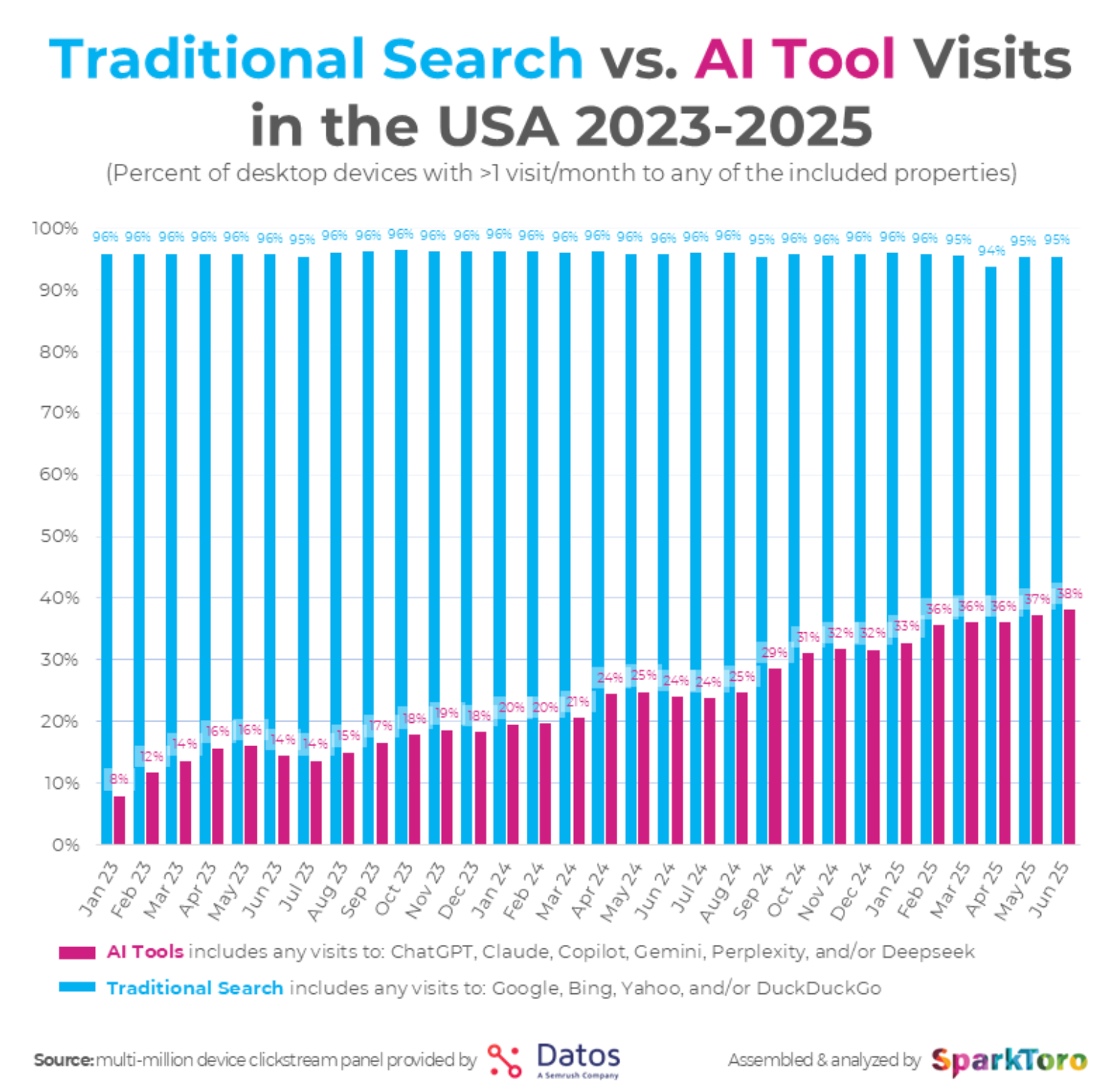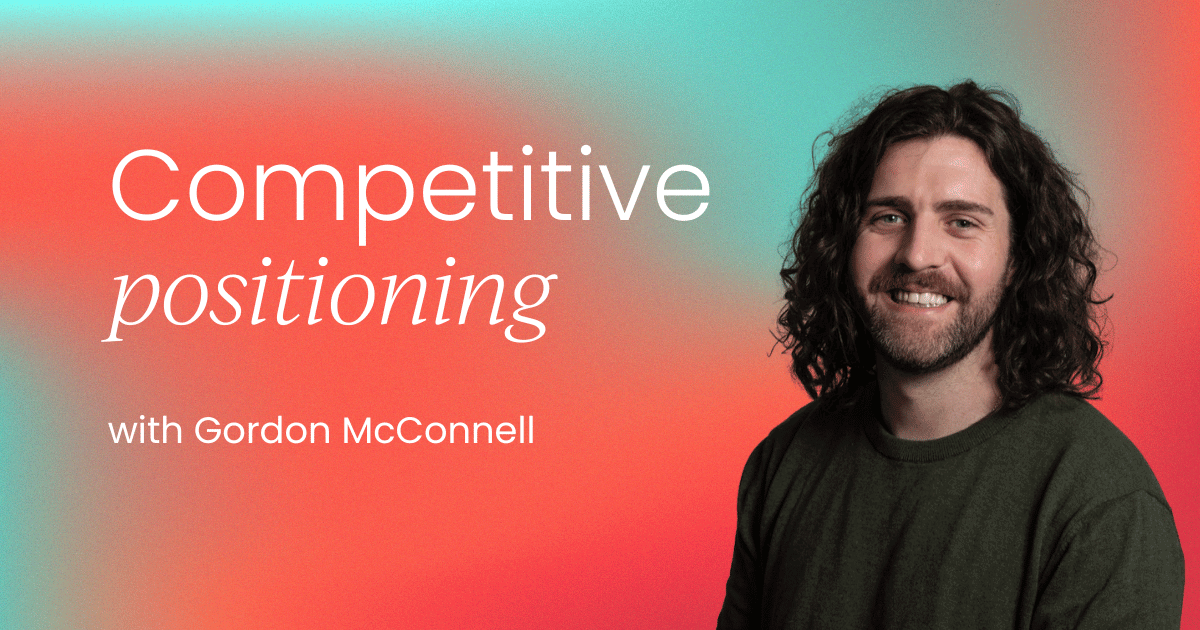Competitive positioning has always been central to product marketing. Whether you work in a sales-led org or a product-led growth (PLG) motion, good positioning means buyers immediately understand what you do and why they should choose you over alternatives.
Traditionally, this meant research, messaging frameworks, landing pages, and sales enablement materials. But today, more and more buyers start their discovery in ChatGPT, Perplexity, Claude, or Google’s AI Overviews.
According to SparkToro, over 20% of Americans now use AI tools ten or more times a month, meaning your next buyer probably does, too – and this number is only going to increase.

In short, if you don’t appear in AI search results, you won’t make buyers’ shortlists. Plus, if you appear with the wrong positioning, you risk being compared on the wrong grounds or users not understanding your unique strengths.
Actively distribute your positioning
This article serves as a blueprint for PMMs to build AI positioning distribution campaigns. Your goals are simple:
- Appear on the shortlist
- Be associated with the right benefits
- Win in competitor comparisons
The ideal scenario? Prospects come to sales meetings already familiar with the benefits they found in their own AI-powered research – no surprises, more informed buyers, and higher conversion rates.
This article will not cover how to build competitive positioning; numerous great resources are available with tried-and-tested frameworks, such as Talya Heller’s guide.
Secondly, we won’t be discussing general answer engine optimization (AEO), i.e, how to increase your visibility in AI tools’ answers. Although the general tactics are more or less the same.
Let’s dig into it!
How ChatGPT is changing discovery
So, what’s wrong with your “vs” page? Well, LLMs don’t just scrape your site. In fact, when it comes to product categories or comparisons, they rarely cite owned articles.
LLMs pull information from:
- Third-party comparison articles (very influential)
- Public communities like Reddit or forums
- Review sites such as G2 and Capterra
- Social mentions (LinkedIn, X)
The takeaway: you need to increase your mentions across the web, especially in trusted, third-party contexts.
This is where your positioning distribution campaign comes into play; you want to influence the AI’s training data as much as possible. Essentially, LLMs operate on word probability, so the more your brand is mentioned positively, with the correct benefits, and in the same context as market leaders, the more likely it is to appear in AI answers.
But before you rush to boost mentions, you need to understand what prompts you’re influencing and how.
Optimize for two key prompt types
Think about AI-driven discovery as two distinct prompt types:
1. Category exploration prompts
Examples:
- “Best project management tools” (generic)
- “Best CRM for small startups” (segment-specific)
These are top-of-funnel, broad discovery queries. To win here, you need:
- A clear, one-sentence positioning statement (what you’re best at or who you serve)
- Tip: Make three to four variants of this using synonyms, so you’re not using the exact same phrase every time.
- Repetition of that positioning across review sites, articles, and mentions
- Mentions alongside market leaders, even if you’re not best overall, being best for X gets you in the conversation
Example messaging table
|
Element |
Example |
|
Main benefit |
Hoolio is the best e-commerce marketing software for small businesses. |
|
Product evidence |
Hoolio integrates with SMB tools like Wix and Shopify, and offers flexible monthly pricing designed for growing teams. |
|
Customer evidence |
90% of Hoolio customers have fewer than 50 employees. |
|
Social proof |
Rated 4.8⭐ on G2 with 250+ reviews mentioning ease of use for small teams. |
2. Direct comparison prompts
Examples:
- “How does Ahrefs differ from Semrush?” (generic comparison)
- “Which is better for dev teams, Monday.com and Asana?” (persona-specific)
These are deeper-funnel, buyer-ready prompts. To win here, you need:
- One main benefit for each competitor
- Two or three supporting benefits
- Evidence for each claimed benefit (feature, customer story, or data)
- Customer reviews or third-party content reinforcing the same point
|
Element |
Example |
|
Main benefit |
Hoolio is better for social media management than Zoolio. |
|
Product evidence |
Hoolio provides social post scheduling and AI-assisted copywriting. Zoolio only monitors linked accounts. |
|
Customer evidence |
40% of Hoolio users doubled their social following within six months. |
|
Social proof |
Rated 4/5⭐ on Capterra with 50+ reviews praising its social media tools. |
Think of it this way: category prompts are about inclusion; comparison prompts are about winning head-to-head.
Seed your positioning across the web
Now that you’ve decided which you are optimizing for, here’s how to ensure your positioning appears in the right places.
☝️But first, some technical SEO and AEO hygiene for your site.
While I’ve mentioned that owned pages are less influential, they’re still powerful tools as we will go on to discuss. So, it’s important your site is as AI-readable as possible.
- Don’t block LLM bots (GPTBot, CCBot, PerplexityBot) in robots.txt.
- Use schema markup to make your product context machine-readable.
- If competitors block AI crawlers, you can gain an edge by being more accessible.
Distribution tactics
You’ll notice that these aren’t new tactics; in fact, most companies incorporate these activities as part of their general marketing efforts. What’s new is the need for product marketers to team up with SEO, PR, and partner marketing on focused positioning campaigns that seed the right messaging.
- Review sites: Keep G2/Capterra profiles updated. Run campaigns asking users (especially switchers) why they chose you and, if applicable, why they switched. Provide a review template to make it easy.
- Third-party comparisons: Pitch publications to update their “best for X” lists with your positioning and proof. Offer new data or insights to add value.
- Owned deep-dives: Write honest “You vs. Competitor” articles. Most writers don’t have time for firsthand research. If you do it, your framing will spread as people draw on it for their own articles.
- Partners and influencers: Ensure integration pages and expert reviews echo your differentiator. Provide analysis and data to strengthen credibility. While you can’t control what partners say exactly, you should provide them with your framework and be comfortable with them mentioning both strengths and weaknesses of your solution.
- Communities (Reddit, Slack, Hacker News): Engage authentically. Be transparent about who you are, back up your claims with data, and respect the community’s tone.
Check out Karmic’s guide to Reddit marketing for tips on navigating this space.
Measure and maintain your AI visibility
You can’t “set it and forget it.” LLMs and AI tools constantly evolve, so you need to track how you’re represented.
- Manual testing: Use Incognito mode and run prompts in ChatGPT, Perplexity, and Gemini like “Best [category] tools,” “Alternatives to [competitor].”
- Visibility tools: Use platforms like Profound, Ahrefs Brand Radar, or Writesonic to see where you’re being cited and what benefits are mentioned.
- Traffic analysis: Track referral traffic from AI tools and compare conversion quality.
- Differentiator check: Does AI reflect your core benefit? If not, revisit your distribution and consistency.
AI reflects the web. If your messaging is fragmented, that’s what buyers will see.
MVP action plan: Winning the “vs. competitor” prompt
Let’s say your positioning is clear, but you’re not the category leader. Here’s a simple, repeatable plan to change that:
- Research and publish a deep-dive comparison: Write an honest “You vs. Competitor” piece with data-backed wins. Identify your strengths and share them on social media (especially LinkedIn).
- Run a reviews push: Encourage recent switchers to explain why they chose you. If you don’t have this data, capture it during onboarding or work with CS.
- Pitch updates to third-party content: Reach out to publishers of “Competitor X alternatives” or “X vs Y” articles with your differentiator and proof.
- Monitor and iterate: LLM updates take time; training data is cut off at certain dates, and each new AI model will be slightly different. Track your mentions quarterly and refresh data regularly.
Do this consistently for three to six months, and you’ll start to see your product appear – and appear correctly – in AI responses.
Conclusion
The fundamentals of positioning haven’t changed; clarity, consistency, and differentiation still win. What has changed is where that positioning gets discovered. Buyers now build their first shortlist inside ChatGPT before they ever reach your homepage.
To succeed, you need to:
- Optimize for two prompt types: category exploration and direct comparisons.
- Seed your messaging across reviews, partners, and communities.
- Keep your site AI-readable and technically sound.
- Monitor how AI tools describe you, and adjust continuously.
In the age of ChatGPT, your positioning isn’t just a sales message; it’s a distributed, AI-readable signal that determines whether your product is even part of the conversation.







